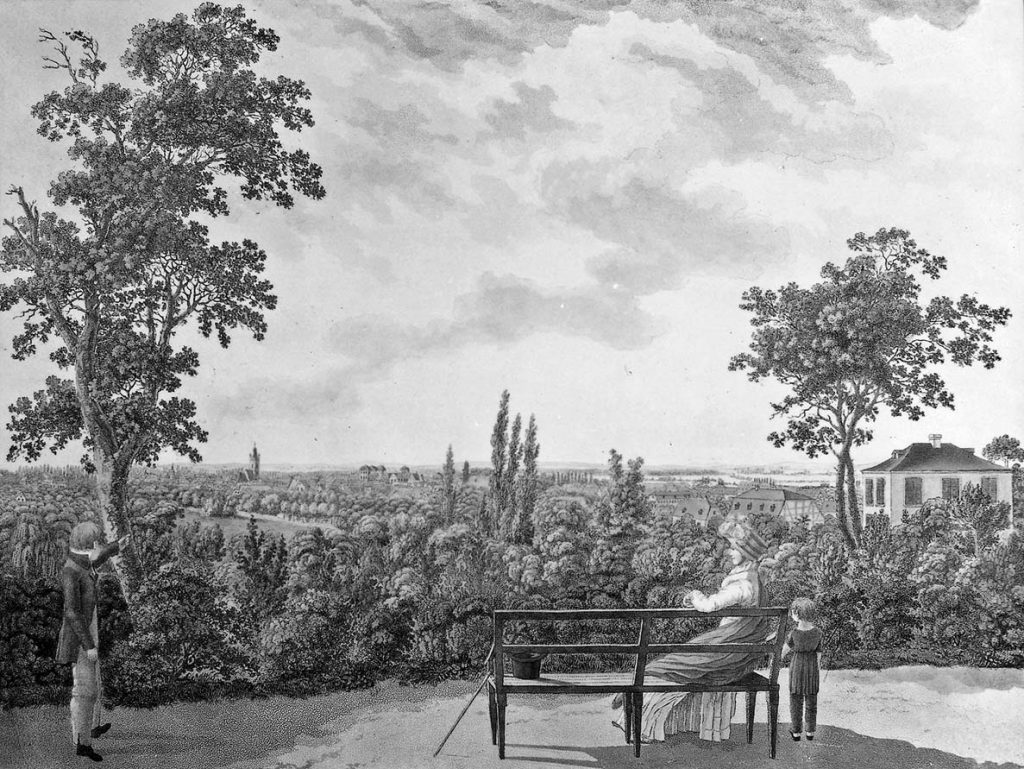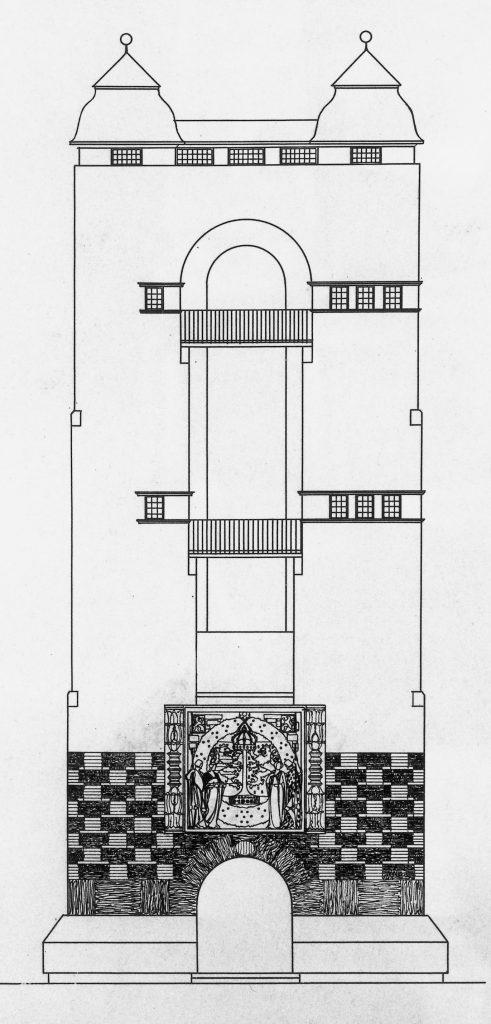There are plenty of towers in and around Darmstadt: Church towers and castle towers, the town hall tower and the tower of the museum, the White Tower, fire station towers, the tower on the Ludwigshöhe, Bismarck towers, viewing towers and many more. But there is one among them that is certainly unique: The Wedding Tower on the Mathildenhöhe. It is visible from afar, even from the Oberfeld situated to the east; and to passengers in the intercity express trains passing Darmstadt in the west it may appear like a vision of a protecting hand held over the city. And those who climb the Wedding Tower will be rewarded by an unrestricted view over the former residence city and state capital, and also over the distant Taunus hills, the Rhine valley, and the nearer Odenwald mountain range.
It has not always been like this. For, in earlier times, the hilly area used to be a vineyard. Around 1800 it was transformed into a bright park. Here, the Darmstadt citizens used to go for a walk representing the cultivated Biedermeier world. At that time, the upper part of the hill was planted with plane trees arranged in a five-nave pattern which made people feel like being in a natural cathedral. Only since 1833, when Grand Duke Ludwig III (1806-1877) married the Bavarian princess Mathilde (1813-1862), has that the area been called Mathildenhöhe. Around the middle of the 19th century the 55,000 inhabitants of Darmstadt were lacking utility and drinking water. For this reason, in 1879/80 a reservoir with a water storage capacity of 4,000 cbm was built east of Mathildenhöhe. The elevated container was covered with earth and planted with bushes and trees. Stairs led through a garden to a platform from where the visitors had a view all over Darmstadt.

On 21st December 1901, the marriage between Grand Duke Ernst Ludwig (25-11-1868 to 09-10-1937) and Princess Victoria Melita (25-11-1876 to 02-03-1936) was dissolved. Three years later, on 21st November, the Grand Duke got engaged to Princess Eleonore zu Solms-Hohensolms-Lich (17-09-1871 to 16-11-1938). Therefore, the representatives of the city of Darmstadt were busy with preparations of the couple’s formal wedding which was scheduled for 2nd February 1905. The city council provided a credit of 20,000 marks for “future events”. Moreover, the wedding couple was supposed to be given a chest designed by Josef Maria Olbrich (22-12-1867 to 08-08-1908). In the 1901 exhibition “A Document of German Art”, the Viennese architect had created a new world of art for the Darmstadt citizens. He consulted the Grand Duke again and both were raving about the idea of creating a widely visible sign, a “large monument, a landmark shaping the city in a unique way”, hence a tower which could represent as “the Wedding Tower a monument of multiple significance”.
As early as in the year 1900, Olbrich had created playful sketches of a tower. In 1905, he resumed these fancy ideas and drew a couple of drafts all of which seemed too cumbersome to him. When, however, on 1st March 1906 the members of the city council agreed to provide 330 000 marks for the “1908 Hesse State Exhibition”, they also approved the Wedding Tower and an adjoining exhibition building. Thereupon, Olbrich got back to work and drew exact plans of the tower according to his ideas. In the Darmstädter Tagblatt of 7th and 8th March 1906 Olbrich described his conception: “The vertical mass of the Wedding Tower in combination with the horizontal building of the exhibition hall form a monumental unity growing out of the urban landscape as a prominent landmark. Seen from afar and from close by, it is supposed to perform the foremost duty of a monument: Bearing mute but eternal testimony of the citizens’ enthusiasm at a time of happiest and most joyful celebration of life!” The description of the building was eloquently illustrated by magnificent watercolour paintings which did not fail to have the desired effect. Finally, the tower together with the exhibition halls could be erected in the years 1907 and 1908 by the Darmstadt building department.







